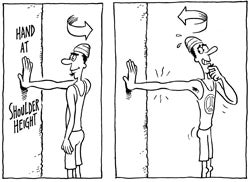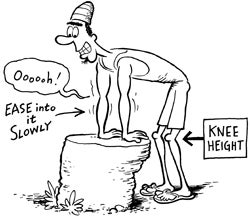Flash Pump Begone! How to Recover from Blasted Forearm Syndrome
Flash pump is real and terrible and can ruin your climbing day. And while the best way to get around flash pump is to avoid it (i.e. warm up), there are tricks to salvaging your post-flash-pump climbing day.
Now you’ve done it. You wanted to wow the entourage, so you warmed up on a route two number grades harder than usual, hoping you would style. You were pumped at bolt two, but hung on anyway, scrapping and flailing skyward out of sheer stubbornness. By the time you went chains, you’d accrued a massive case of Blasted Forearm Syndrome (BFS): that burning, tight, tingling flash pump that signals the end of any real climbing for the day. Don’t slink back to the campsite yet, though—there is hope. With a few stretches and lactic-acid-shunting routines, you can still recover and clip the steel gates of success, winning the hearts and admiration of fawning groupies everywhere.
Massage.
To break up the bunched, rigid muscles in your guns, you’ll need to go deep. Create a loose fist with one hand and rub the knuckles down the forearm of the other, twisting slightly. Work a grid pattern, pressing just to the point of pain then releasing after five seconds; describe a series of pressure points from wrist to elbow. Let your hand flop where it will. You can also massage with your thumb, rub your forearm crosswise with the heel of your hand, and/or massage the inside of the palm to release your finger tendons.
Stretch.
Once you’ve worked both arms, gently stretch for five to 10 minutes. Your motions should be steady and sure—no bouncing—and you should hold each stretch for at least 10 to 15 seconds. Hold your hand palm out, as if stopping traffic. Pull back on the fingertips of that hand with the other for 10 seconds; release. You can also go finger by finger, and/or point your fingers toward the earth — the key is to extend your wrist. To stretch the top of the forearm, flex your wrist, cupping and bending your hand toward you, and pull gently on the cupped paw with your other hand.

Now, face the crag and place one hand, palm oriented vertically, flat against the wall at shoulder height. Gradually rotate away from the hand until you feel a subtle stretch along the inner arm and into your pecs and shoulders. You can play with rotating your outstretched palm to the left or right, too. Alternately, if you can find a flat surface at knee to hip height, lean over, then place your hands flat, fingers facing backward, and move into the stretch. You can also do this on all fours, or one hand at a time if it stresses your wrists too much with both.

Iron.
Properly stretched, get to ironing. With one hand in a karate-chop position, palm facing you, “iron” your opposite forearm from elbow to wrist. Use a steady, gentle pressure and move slowly, repeating as necessary. Do the same for the extensor muscles on the top (outside) of your arm. Now, flex and extend your fingers to bring blood to your digits, and rotate your wrists in small circles.
Regaining your stride.
Repeat the above routine as necessary—I might go through it two or three times before I jump back on the rock. Keep the bar low for a bit, staying on easier, more vertical terrain until you feel normal, healthy blood flow returning. You may want to massage and stretch before each route for the rest of the day, and forego the proj. I’ve suffered week-long cases of BFS when I didn’t listen to my body.
Matt “Spaghetti Arms” Samet is Senior Editor at Climbing.